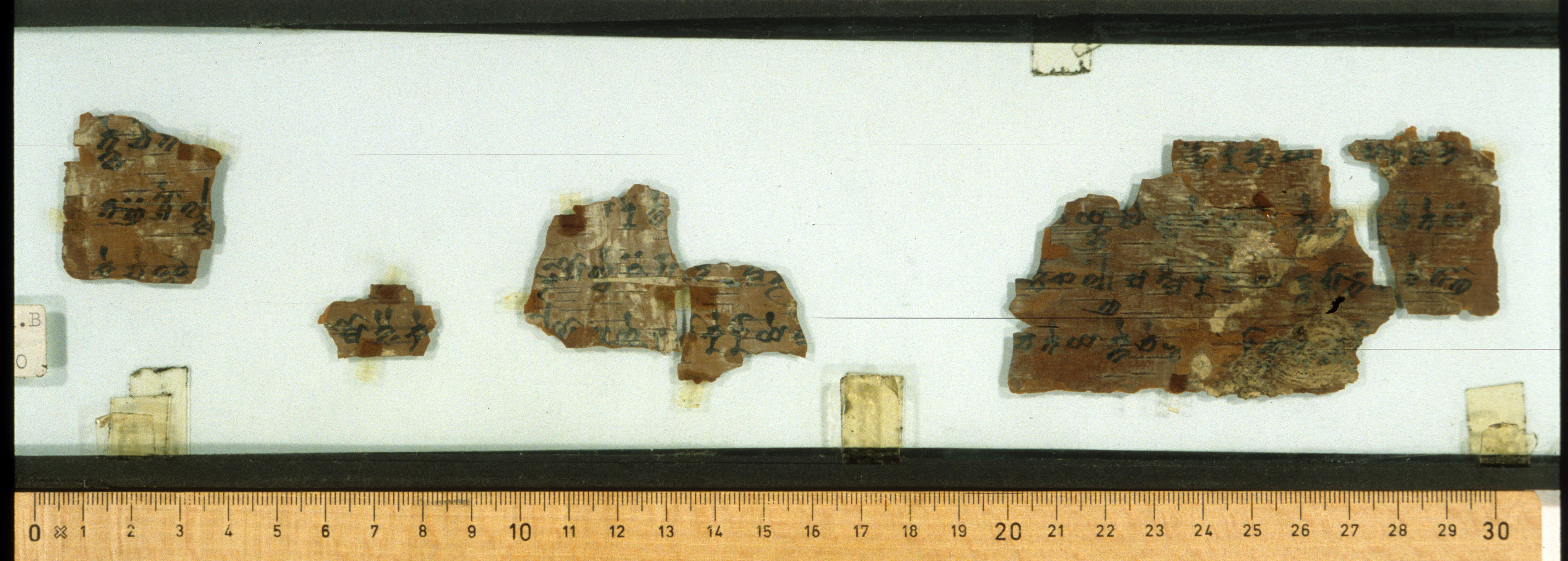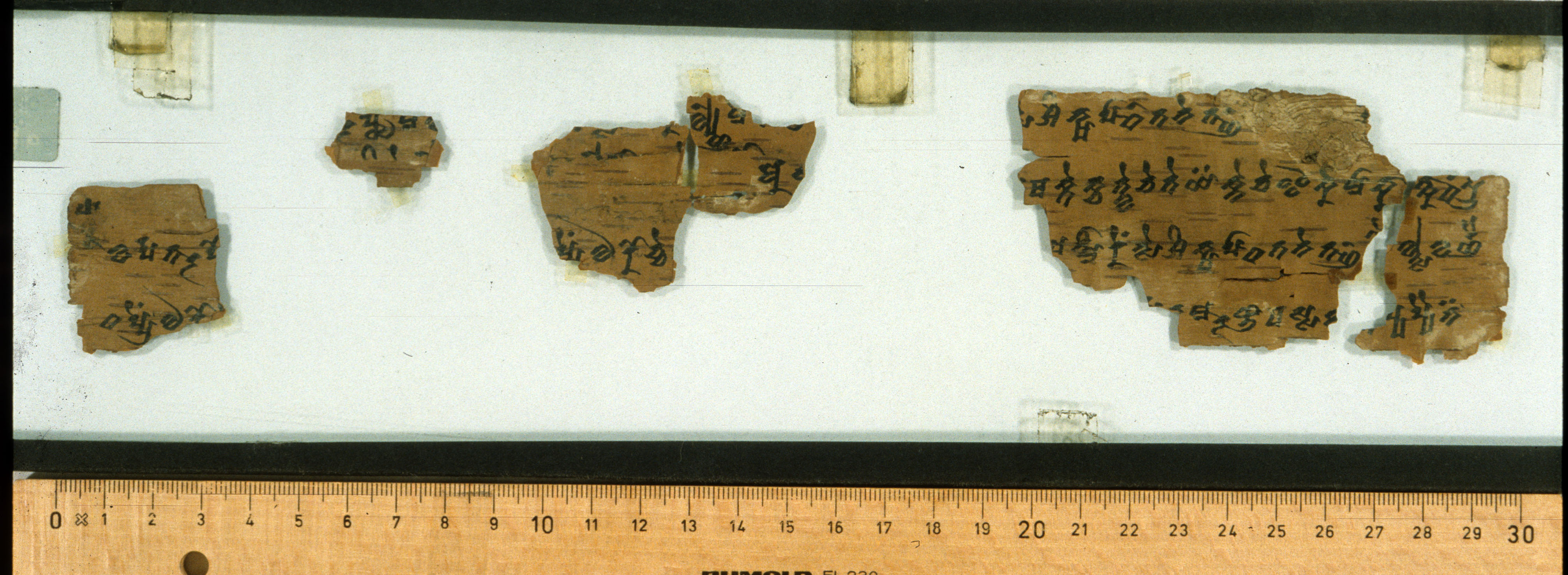THT 1103
| Known as: | THT 1103; KVāc 10 |
|---|---|
| Cite this page as: | Melanie Malzahn; Hannes A. Fellner (collaborator); Theresa Illés (collaborator). "THT 1103". In A Comprehensive Edition of Tocharian Manuscripts (CEToM). Created and maintained by Melanie Malzahn, Martin Braun, Hannes A. Fellner, and Bernhard Koller. https://cetom.univie.ac.at/?m-tht1103 (accessed 15 Jul. 2025). |
Edition | |
| Editor: | Melanie Malzahn; Hannes A. Fellner (collaborator); Theresa Illés (collaborator) |
| Date of online publication: | 2015-02 |
Provenience | |
| Main find spot: | Unknown |
| Collection: | Berlin Turfan Collection |
Language and Script | |
| Language: | TB |
| Linguistic stage: | classical |
| Script: | classical |
Text contents | |
| Title of the work: | Karmavācanā |
| Passage: | Upasaṃpadā (pravrajyā; daśaśikṣāpadāni) |
| Text genre: | Literary |
| Text subgenre: | Vinaya |
| Verse/Prose: | prose |
Object | |
| Manuscript: | THT 1102-1125 |
| Preceding fragment: | THT 1102 |
| Following fragment: | THT 1104 |
| Material: | ink on wood tablet |
| Form: | Poṭhī |
| Size (h × w): | 5.6 × 29 cm |
| Number of lines: | 4 |
Images
Images from idp.bbaw.de by courtesy of the International Dunhuang Project Berlin, the Berlin-Brandenburgische Akademie der Wissenschaften, and the Staatsbibliothek zu Berlin – Orientabteilung.
Transliteration
(continues from THT 1102)
| lf | 10 [7] |
|---|---|
| a1 | twe ce t(·) /// /// nm[i] r[eṃ] tse s̝a (–) pā¯ ¯t ta ne |
| a2 | ta¯ ¯ñä śau ltsa /// /// [ṣ](·) re nte /// /// n(·) yku sai mpa ṣe sa • [ma] kte kca [t]w(·) ce te yä |
| a3 | k(·)e c(·)e ī /// /// ¯r• po ñce wä rpa n(·) m(·)¯ ¯r /// /// [r]ka s̝a lyñ[e] ṣa nmī reṃ tse śa kṣa pā¯ ¯t• [t](·) ne ta¯ ¯ñ |
| a4 | (– – – – –) (·)[ā] mo wai ke (– – – –) [l](·)e po [s](·)(·)ṃ ñ[ñ]e r· [no] ke rī ye m(·) (– – – – –) c[e] te ya kne ce [ī] (–) [m]ā kā [tka¯] [¯t] [kru]i (– – –) |
| b1 | /// ¯r 4 m(·) [l](·) (– – –) – (·)s(·) (–) [k](·) lyñe m[e] (–) [ka] (– – – – –) [tse] śi kṣa pā¯ ¯t• ta ne ta¯ ¯ñ• [ś](·) (– – –) |
| b2 | /// (·)i (·)e l(·)e (– – –) (·)[o] (–) le (·)o (–) (·)e (–) (·)o a [s](·)(·) (– – – – –) ma kte kca twe ce te yä kne ce ī ke mā kā tka¯ ¯t• krui |
| b3 | wa rpa ta¯ ¯r [p]o /// /// pp(·)eṃ o ro cce /// /// ṣa nmī reṃ tse śi kṣa pā¯ ¯t ta ne ta¯ ¯ñ• (·)au ltsa wa rñai |
| b4 | ta ppreṃ o ro (·)(·)e /// /// [rp](·) [na] ma¯ ¯r 6 pa ssa [ka](·) [t](·) [p]y(·) pyai nä |
(continues on THT 1104)
Transcription
(continues from THT 1102)
| lf | 10-7 |
| a1 | n1n2n3 twe ce t(e-yäknece) /// /// (ṣa)nmireṃtse ṣä(kṣa)pāt tane | |
|---|---|---|
| a2 | n4n5 tañ śaultsa /// /// ṣ·rente /// /// n· ykusaimpa ṣesa • mäkte kca tw(e) ce te-yä¬ | |
| a3 | k(n)ec()en5n6 ī(ke) /// /// (warpata)r poñ ce wärpan(a)m(a)r /// /// (na)rkäṣälyñe ṣanmīreṃtse śäkṣapāt t(a)ne tañ | |
| a4 | n7n8 – – – – (päkn)āmo waike (mā) (weṣä)l(l)e pos(ta)ṃññe r(a)no kerīyem(ane) – – – – ce te-yaknece ī(ke) mā kātkat krui – – – | |
| b1 | n9n10 /// (wärpanama)r 4 m(ā)l(a) – – – – ·s· (yo)k(a)lyñeme(ṃ) (nar)kä(ṣälyñe) (ṣanmīreṃ)tse śikṣapāt tane tañ ś(aultsa) (warñai) | |
| b2 | n11n12n13n14 /// (tr)i(k)el()e – – – (y)o(ka)le (p)o(staññ)e (ran)o as(kwacentse) (ākesa) mäkte kca twe ce te-yäknece īke mā kātkat krui | |
| b3 | n15 warpatar po(ñ) /// /// (tä)pp(r)eṃ orocce /// /// ṣanmīreṃtse śikṣapāt tane tañ (ś)aultsa warñai | |
| b4 | n16 täppreṃ oro(cc)e /// /// (wä)rp(a)namar 6 pässakä(n)t(a) py(a)pyainä¬ | |
| * | (ṣṣe) |
(continues on THT 1104)
Translation
(continues from THT 1102)
| a1 | you (shall not) go (beyond such a point [= become guilty of such an offence]. If you accept this, say: I accept. 3. Refraining from sexual intercourse), [this is a] commandment for a novice. Therefore |
|---|---|
| a2 | you (shall not in your whole) live .... (practise sexual intercourse,) [not] (even) with one going (with a horizontal womb). Whatever [the circumstances], do not (go) beyond such |
| a3 | (a point [= become guilty of such an offence]! If you accept this) say: I accept. 4. Refraining from (telling a lie), [this is a] commandment for a novice. Therefore you shall |
| a4 | (not in your whole life, deliber)ately tell a lie, [not] even laughing [= as a joke]. (Whatever [the circumstances]), do not go beyond such a point! If (you accept this) |
| b1 | (say: I accept. 5. Refraining) from (drink)ing alcohol, (inebriating beverages [or] brandy), [this is a] commandment for (a novice). Therefore you shall (your whole life) |
| b2 | drink no alcohol,) inebriating beverage (?) [or] brandy, ([not] even with the tip of) [a blade of] Kuś(a-grass). Whatever [the circumstances], do not go beyond such a point! If |
| b3 | you accept this, say: (I accept. 6. Refraining from) [the use of] high [and] broad (beds), [this is a] commandment for a novice. Therefore your whole life |
| b4 | you (shall not use) high [and] broad] (beds. Whatever [the circumstances], do not go beyond such a point! If you accept this, say:) I accept. (7. Refraining from putting garlands, (odours of) flowers, |
(continues on THT 1104)
Other
| b2 | You mustn't cross this point on any account! (Peyrot 2013b: 308) |
|---|
Commentary
Parallel texts
| for Sanskrit see Härtel 1956: 53-55, for Sanskrit and Chinese Chung 2004: 46-47 and for Tumšuqese Bailey 1950: 649-670; Emmerick 1985 |
Philological commentary
| The identification, ordering and extensive supplementation of the fragments of leaves 9-11 (THT 1102 – THT 1104) is facilitated largely by parallel texts from Sanskrit Buddhist literature. Thus THT 1102 a1-2 is relatively closely matched by the Sanskrit text as restored from fragments of Turfan mss. by Härtel 1956: 51, and THT 1102 a2 – THT 1103 b3 may be compared with a Sanskrit text, also restored from Turfan fragments by Härtel 1956: 54-55. The former of the two is a section of text that can be found repeatedly in the Buddhist Sanskrit-tradition, such as CPS 16.16, 17.13, 22.15, 27f.22, NidSa 20.17, ŚPrSū 111, BimbSū 143. The Sanskrit text mentioned by Härtel 1956: 53 deviates slightly from these as does the Chinese parallel having five commandments [pañcaśikṣāpadāni]; see Chung 2004: 46-47. Beyond this a further parallel can be found, which surprisingly enough and except for a few minor deviations is remarkably close to the Tocharian text, and which therefore contributes greatly to supplementing our text here. It is a Tumšuqese Karmavācanā text (cf. Bailey 1950: 649-670; Emmerick 1985 for further reading) which from line 12-62 conforms almost verbatim to THT 1102 a1 – THT 1103 a3. Further important supplementations are owed to the TB fragments IOL Toch 92 and PK NS 175. Certain deviations are caused by the fact that in the various versions occasionally different groups of persons are addressed. Thus the Sanskrit parts, the Tumšuqese text and IOL Toch 92 contain formulas directed at lay followers (male, not female, as wrongly identified by Emmerick 1985: 9ff), while our text here contains directives for novices. The small fragment PK NS 175 does not allow for any closer designation in this respect. | ||||||||||||||||||||||||||||||||||
The text of the first five commandments of the Tocharian version could be largely completed with the help of the Skt. text supplied in Härtel 1956: 54f, as well as – at least for commandments 1-3 – that of the Tumšuqese KaVā text. As for commandments 6-10, the Indic parallel versions (such as the Bhikṣukarmavākya, which belongs to the Mūlasarvāstivādin school) offer no more than mere lists of offences. For the Chinese Sarvāstivādin version cf. Chung 2004 and Ogihara 2009: 14, 570ff. When one compares the Tocharian version with the Sanskrit text from the Bhikṣukarmavākya (p. 21) and the Pāli text from the Mahāvagga (I.56) the following picture emerges:
| ||||||||||||||||||||||||||||||||||
| While commandments 1-4 – the supplementations of the Toch. text may be considered certain – do agree quite well in the various versions, commandments 5, 7, 8 (the Toch. text may be supplemented with certainty) and 9 display a number of differences in content, which render a persistent equation of the Tocharian sections with their respective counterparts in the Skt. and Pāli versions impossible. | ||||||||||||||||||||||||||||||||||
| The supplementations and commentaries follow Schmidt 1986: 8, 125-126. | ||||||||||||||||||||||||||||||||||
| n1 | About 31 akṣaras are missing at the end of the first fragment. | |||||||||||||||||||||||||||||||||
| n2 | Schmidt 1986: 43 restores to (maithunmeṃ narkäṣälyñe śa)nmireṃtse..., cf. A 243 b2 (pu)k maithunantwaṣ tmäkyok ñañ(ä)rkunt “[to you] who for this very reason has refrained from (an) sexual intercourse” (plural in Toch.), a somewhat freer rendering of Skt. uṣitabrahmacaryāya “[to thee,] who dwelt in the way of the brahmacārin” (the beginning of verse II.20 of Mātṛceṭa’s Varṇārhavarṇa-stotra. Text and translation Shackleton Bailey 1950: 682f. | |||||||||||||||||||||||||||||||||
| n4 | A gap of about 9 akṣaras at the end of the first fragment, and a gap of about 11 at the end of the second. The reading śaulatsa of Tamai 2014: 366 is wrong. ṣ·rette can also be read instead of ṣ·rente. | |||||||||||||||||||||||||||||||||
| n5 | Without knowledge of its Skt. equivalent, n· ykusaimpa ṣesa, lit. “together with one [fem.] ... who has gone ...”, remains unclear. It is, however, the remainder of an element-by-element translation of Skt. tiryag-yoni-gatayā ... sārdham “with a [female] animal”, where n· translates Skt. yoni and ykusaimpa translates Skt. gatayā. tiryag-yoni-gatā literally means “one going with a horizontal womb”. | |||||||||||||||||||||||||||||||||
| n6 | A gap of about 9 akṣaras at the end of the first fragment, and of about 7 at the end of the second. | |||||||||||||||||||||||||||||||||
| n8 | On the supplementation of waike (mā weṣä)l(l)e pos(ta)ṃññe r(a)no kerīyem(ane) cf. THT 333 a 10 postäñe rano keriyemane waiyke mā weṣṣälle. | |||||||||||||||||||||||||||||||||
| n10 | A gap of 7 akṣaras in the first fragment. | |||||||||||||||||||||||||||||||||
| n13 | A gap of 7-8 akṣaras in the first fragment. | |||||||||||||||||||||||||||||||||
| n14 | as(kwacentse ākesa) has been supplemented with THT 308 b3 askwacentse ākesa based on the on Skt. kuśāgreṇa- "the sharp point of a blade of the Kuśa grass" in the Sanskrit parallel. The amendation of Tamai 2014: 366 (y)o(ks)le is wrong (and probably a misprint). | |||||||||||||||||||||||||||||||||
| n15 | A gap of about 8 akṣaras at the end of the first fragment, and about 7 at the end of the second. | |||||||||||||||||||||||||||||||||
| n16 | A gap of about 27 akṣaras at the end of the first fragment. |
Remarks
| According to Schmidt 1986: iv-v the ms. comes either from Qizil or from Tumšuq. | |
| Of the original leaf 4 fragments remain: a smaller one from the left margin, about 3 cm wide and containing remnants of 3 and 2 lines respectively; another small fragment from beneath the string hole, about 2 cm wide and containing remnants of 1 and 2 lines respectively; a smaller fragment to the right of the string hole, connected up in two places, about 5 cm wide and containing remnants of 3 lines, with the verso partly abraded; and a fragment from the right side consisting of 2 pieces and about 9 cm wide. | |
| The original ms. was 29 cm wide and 5.6 cm high, with the string hole 6.5 cm from the left margin. It was written by at least three hands: scribe 1, a beautiful, delicate script, from leaf 1 to 11 a1; scribe 2, distinguished by a number of orthographical idiosyncrasies/errors, from leaf 11 a1 to and including 19; scribe 3 from leaf 20 to end. The final leaves A and B THT 1123 and THT 1124 may have been written either by scribe 2 or a fourth hand. Cf. Schmidt 1986: v, 2-3. | |
| This leaf is in hand 1. |
Linguistic commentary
| n3 | ṣäkṣapāt for ṣikṣapāt. |
|---|---|
| n7 | te-yaknece for te-yäknece. |
| n9 | m(ā)l(a) – – – – ·s· is restored to m(ā)l(a trikelye śak)s(e) by Schmidt 1986: 43. It is, however, problematic to compare this phrase to Skt. surā-maireya-madya- since in another ms. (IOL Toch 246: b2) the TB equivalent of the same Skt. phrase is mot māla trikelyesa śakse. According to this latter Hoernle passage mot has been equalled with Skt. surā- “brandy”, mālo* with Skt. maireya- (the name for an inebriating drink), and trikelle with Skt. madya- “inebriating drink, brandy” (TEB II: q.v.), while śakse has been disregarded. These equations, however, become questionable, if one takes into consideration that śikse (sic!) is attested as a translation of Skt. madya in SHT 1704 b4 (cf. Malzahn 2007b: 309), wherefore it is recommended here to regard mot “alcohol” as a cover term for alcoholic beverages, and , starting out from this passage here, to identify mālo* with Skt. surā-, trikelle with Skt. maireya- and śakse with Skt. madya-. |
| n11 | An alternative supplementation, of course, would be (tr)i(k)el(ye) (Obl.). In this case, then, it would be an impersonal gerundive construction with a dependent oblique case, which is repeatedly attested in this text, and to which cf. Thomas 1952: 22ff. |
| n12 | kātkat (likewise line a4 and THT 1104 a2), which belongs to kätk- “cross, walk over”, displays the initially accented full grade form kātk- that is to be expected in a singular active of Sub.V. |
References
Online access
IDP: THT 1103; TITUS: THT 1103
Complete Translation
Tamai 2014: 366-367; Schmidt 1986: 70-71
Edition
Tamai 2014: 366-367; Tamai 2007a: №1103; Schmidt 1986: 8, 42-43
Translations
Peyrot 2013b: a1 (308, 700), a2 a3 (308), a3 (700), a4 b1 (308, 700), b2 (308), b2 b3 (700), b4 (308, 700)
Bibliography
Bailey, Harold W. 1950. “The Tumshuq Karmavācanā.” Bulletin of the School of Oriental and African Studies, University of London 13 (3): 649–70.
Chung, Jin-il. 2004. Das Upasaṃpadāvastu, Vorschriften für die buddhistische Mönchsordination im Vinaya der Sarvāstivāda-Tradition, Sanskrit-Version und chinesische Version. Sanskrit-Wörterbuch der buddhistischen Texte aus den Turfan-Funden, Beiheft 11. Göttingen: Vandenhoeck & Ruprecht.
Emmerick, Ronald E. 1985. “The Tumshuqese Karmavācanā text.” Akademie d. Wissenschaften u.d. Literaturen, Abhandlungen d. Geistes- u. Sozialwissenschaftlichen Klasse Wiesbaden 2: 1–34.
Härtel, Herbert. 1956. Karmavācanā. Formulare für den Gebrauch im buddhistischen Gemeindeleben aus ostturkestanischen Sanskrit-Handschriften. Sanskrittexte aus den Turfanfunden, III. Berlin: Akademie-Verlag.
“The International Dunhuang Project: The Silk Road Online.” n.d. http://idp.bl.uk.
Malzahn, Melanie. 2007b. “A preliminary survey of the Tocharian glosses in the Berlin Turfan Collection.” In Instrumenta Tocharica, edited by Melanie Malzahn, 301–19. Heidelberg: Winter.
Ogihara, Hirotoshi. 2009. “Researches about Vinaya-texts in Tocharian A and B [Recherches sur le Vinaya en tokharien A et B].” PhD, Paris: École Pratique des Hautes Études.
Peyrot, Michaël. 2013b. The Tocharian subjunctive. A study in syntax and verbal stem formation. Vol. 8. Brill’s Studies in Indo-European Languages & Linguistics. Leiden/Boston: Brill.
Schmidt, Klaus T. 1986. “Fragmente eines buddhistischen Ordinationsrituals in westtocharischer Sprache. Aus der Schule der Sarvāstivādins. Text, Übersetzung, Anmerkungen und Indizes.” Habilitation.
Shackleton Bailey, David Roy. 1950. “The Varṇārhavarṇa Stotra of Mātṛceṭa (I).” Bulletin of the School of Oriental and African Studies 13 (3): 671–701.
Tamai, Tatsushi. 2007a. “A preliminary edition of unpublished texts from the Berlin Turfan Collection.” Thesaurus indogermanischer Text- und Sprachmaterialien (TITUS): Tocharian manuscripts from the Berlin Turfan collection. 2007. http://titus.fkidg1.uni-frankfurt.de/texte/tocharic/tht.htm.
Tamai, Tatsushi. 2014. “The Tocharian Karmavācanā.” Annual Report of the International Research Institute for Advanced Buddhology (ARIRIAB) at Soka University for the Academic Year 2013 17: 365–94.
Thomas, Werner, and Wolfgang Krause. 1964. Tocharisches Elementarbuch, Band II. Texte und Glossar. Heidelberg: Winter.
Thomas, Werner. 1952. Die tocharischen Verbaladjektive auf -l. Deutsche Akad. der Wissenschaften zu Berlin, Institut für Orientforschung 9. Berlin: Akademie-Verlag.
Gippert, Jost, Katharina Kupfer, Christiane Schaefer, and Tatsushi Tamai. n.d. “Thesaurus Indogermanischer Text- und Sprachmaterialien (TITUS): Tocharian Manuscripts from the Berlin Turfan Collection.” http://titus.fkidg1.uni-frankfurt.de/texte/tocharic/thtframe.htm.




